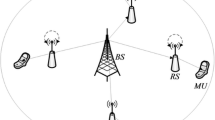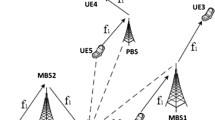Abstract
Hybrid duplex wireless networks, use half duplex (HD) as well as full duplex (FD) modes to utilize the advantages of both technologies. This paper tries to determine the proportion of the network nodes that should be in HD or FD modes in such networks, to maximize the overall throughput of all FD and HD nodes. Here, by assuming imperfect self-interference cancellation (SIC) and using ALOHA protocol, the local optimum densities of FD, HD and idle nodes are obtained in a given time slot, using Karush–Kuhn–Tucker (KKT) conditions as well as stochastic geometry tool. We also obtain the sub-optimal value of the signal-to-interference ratio (SIR) threshold constrained by fixed node densities, using the steepest descent method in order to maximize the network throughput. The results show that in such networks, the proposed hybrid duplex mode selection scheme improves the level of throughput. The results also indicate the effect of imperfect SIC on reducing the throughput. Moreover, it is demonstrated that by choosing an optimal SIR threshold for mode selection process, the achievable throughput in such networks can increase by around 5%.






Similar content being viewed by others
Notes
The link distance R can also be random without affecting the main results such as success probabilities and maximal throughput, since we can always derive the results by first conditioning on R and then averaging over it [24].
References
Li, R., Chen, Y., Li, G. Y., & Liu, G. (2017). Full-duplex cellular networks. IEEE Communications Magazine, 55(4), 184–191. https://doi.org/10.1109/MCOM.2017.1600361CM.
Naslcheraghi, M., Ghorashi, S. A., & Shikh-Bahaei, M. (2017). Full-duplex device-to-device collaboration for low-latency wireless video distribution. In 2017 24th International conference on telecommunications (ICT) (pp. 1–5). https://doi.org/10.1109/ICT.2017.7998228.
Zhang, Z., Long, K., Vasilakos, A. V., & Hanzo, L. (2016). Full-duplex wireless communications: Challenges, solutions, and future research directions. Proceedings of the IEEE, 104(7), 1369–1409. https://doi.org/10.1109/JPROC.2015.2497203.
Naslcheraghi, M., Ghorashi, S. A., & Shikh-Bahaei, M. (2017). Fd device-to-device communication for wireless video distribution. IET Communications, 11(7), 1074–1081. https://doi.org/10.1049/iet-com.2016.0675.
Sharma, S. K., Bogale, T. E., Le, L. B., Chatzinotas, S., Wang, X., & Ottersten, B. (2018). Dynamic spectrum sharing in 5G wireless networks with full-duplex technology: Recent advances and research challenges. IEEE Communications Surveys Tutorials, 20(1), 674–707. https://doi.org/10.1109/COMST.2017.2773628.
Ernest, T. Z. H., Madhukumar, A. S., Sirigina, R. P., & Krishna, A. K. (2019). Outage analysis and finite snr diversity-multiplexing tradeoff of hybrid-duplex systems for aeronautical communications. IEEE Transactions on Wireless Communications, 18(4), 2299–2313. https://doi.org/10.1109/TWC.2019.2902550.
Wei, Z., Sun, S., Zhu, X., Huang, Y., & Wang, J. (2018). Energy-efficient hybrid duplexing strategy for bidirectional distributed antenna systems. IEEE Transactions on Vehicular Technology, 67(6), 5096–5110. https://doi.org/10.1109/TVT.2018.2814047.
Ernest, T. Z. H., Madhukumar, A. S., Sirigina, R. P., & Krishna, A. K. (2019). A hybrid-duplex system with joint detection for interference-limited uav communications. IEEE Transactions on Vehicular Technology, 68(1), 335–348. https://doi.org/10.1109/TVT.2018.2878889.
Naslcheraghi, M., Ghorashi, S. A., & Shikh-Bahaei, M. (2017). Performance analysis of inband fd-d2d communications with imperfect si cancellation for wireless video distribution. In 2017 8th International conference on the network of the future (NOF) (pp. 176–181). https://doi.org/10.1109/NOF.2017.8251246.
Cao, Y., Zhao, N., Pan, G., Chen, Y., Fan, L., Jin, M., et al. (2019). Secrecy analysis for cooperative noma networks with multi-antenna full-duplex relay. IEEE Transactions on Communications, 67(8), 5574–5587. https://doi.org/10.1109/TCOMM.2019.2914210.
Chen, B., Chen, Y., Chen, Y., Cao, Y., Ding, Z., Zhao, N., et al. (2019). Secure primary transmission assisted by a secondary full-duplex noma relay. IEEE Transactions on Vehicular Technology, 68(7), 7214–7219. https://doi.org/10.1109/TVT.2019.2919873.
Wang, K., Yu, F. R., Wang, L., Li, J., Zhao, N., Guan, Q., et al. (2019). Interference alignment with adaptive power allocation in full-duplex-enabled small cell networks. IEEE Transactions on Vehicular Technology, 68(3), 3010–3015. https://doi.org/10.1109/TVT.2019.2891675.
Gaber, A., Youssef, E., Rizk, M. R. M., Salman, M., & Seddik, K. G. (2020). Cooperative delay-constrained cognitive radio networks: Delay-throughput trade-off with relaying full-duplex capability. IEEE Access (pp. 1–1). https://doi.org/10.1109/ACCESS.2020.2964565.
Wang, X., Huang, H., & Hwang, T. (2016). On the capacity gain from full duplex communications in a large scale wireless network. IEEE Transactions on Mobile Computing, 15(9), 2290–2303. https://doi.org/10.1109/TMC.2015.2492544.
Haenggi, M. (2012). Stochastic geometry for wireless networks. Cambridge: Cambridge University Press.
Tang, W., Feng, S., Liu, Y., & Ding, Y. (2016). Hybrid duplex switching in heterogeneous networks. IEEE Transactions on Wireless Communications, 15(11), 7419–7431. https://doi.org/10.1109/TWC.2016.2602329.
Thanh, P. D., Hoan, T. N. K., & Koo, I. (2019). Joint resource allocation and transmission mode selection using a pomdp-based hybrid half-duplex/full-duplex scheme for secrecy rate maximization in multi-channel cognitive radio networks. IEEE Sensors Journal,. https://doi.org/10.1109/JSEN.2019.2958966.
Liu, J., Han, S., Liu, W., & Yang, C. (2017). The value of full-duplex for cellular networks: A hybrid duplex-based study. IEEE Transactions on Communications, 65(12), 5559–5573. https://doi.org/10.1109/TCOMM.2017.2743689.
Li, S., Zhou, M., Wu, J., Song, L., Li, Y., & Li, H. (2017). On the performance of x-duplex relaying. IEEE Transactions on Wireless Communications, 16(3), 1868–1880. https://doi.org/10.1109/TWC.2017.2656887.
Kwon, T., & Lee, H. (2018). Hybrid duplex wireless peer discovery with imperfect self-interference cancellation. IEEE Communications Letters, 22(3), 598–601. https://doi.org/10.1109/LCOMM.2017.2780095.
Otyakmaz, A., Schoenen, R., Dreier, S., & Walke, B. H. (2008). Parallel operation of half- and full-duplex fdd in future multi-hop mobile radio networks. In 2008 14th European wireless conference (pp. 1–7). https://doi.org/10.1109/EW.2008.4623892.
Yamamoto, K., Haneda, K., Murata, H., & Yoshida, S. (2011). Optimal transmission scheduling for a hybrid of full- and half-duplex relaying. IEEE Communications Letters, 15(3), 305–307. https://doi.org/10.1109/LCOMM.2011.011811.101925.
Lee, J., & Quek, T. Q. S. (2015). Hybrid full-/half-duplex system analysis in heterogeneous wireless networks. IEEE Transactions on Wireless Communications, 14(5), 2883–2895. https://doi.org/10.1109/TWC.2015.2396066.
Tong, Z., & Haenggi, M. (2015). Throughput analysis for full-duplex wireless networks with imperfect self-interference cancellation. IEEE Transactions on Communications, 63(11), 4490–4500. https://doi.org/10.1109/TCOMM.2015.2465903.
Hemachandra, K. T., & Fapojuwo, A. O. (2017). Distance based duplex mode selection in large scale peer-to-peer wireless networks. In 2017 IEEE International conference on communications (ICC) (pp. 1–6). https://doi.org/10.1109/ICC.2017.7996444.
Yao, Y., Li, B., Li, C., Yang, C., & Xia, B. (2020). Downlink performance analysis of the full-duplex networks with interference cancellation. IEEE Transactions on Communications,. https://doi.org/10.1109/TCOMM.2020.2965536.
Zheng, T., Wang, H., Yuan, J., Han, Z., & Lee, M. H. (2017). Physical layer security in wireless ad hoc networks under a hybrid full-/half-duplex receiver deployment strategy. IEEE Transactions on Wireless Communications, 16(6), 3827–3839. https://doi.org/10.1109/TWC.2017.2689005.
Li, Y., Wang, T., Zhao, Z., Peng, M., & Wang, W. (2015). Relay mode selection and power allocation for hybrid one-way/two-way half-duplex/full-duplex relaying. IEEE Communications Letters, 19(7), 1217–1220. https://doi.org/10.1109/LCOMM.2015.2433260.
Fang, Z., Ni, W., Liang, F., Shao, P., & Wu, Y. (2017). Massive mimo for full-duplex cellular two-way relay network: A spectral efficiency study. IEEE Access, 5, 23288–23298. https://doi.org/10.1109/ACCESS.2017.2766079.
Gazestani, A. H., Ghorashi, S. A., Mousavinasab, B., & Shikh-Bahaei, M. (2019). A survey on implementation and applications of full duplex wireless communications. Physical Communication, 34, 121–134. https://doi.org/10.1016/j.phycom.2019.03.006.
Towhidlou, V., & Shikh-Bahaei, M. (2019). Full-duplex d2d communications in vehicular networks. In 2019 IEEE Wireless communications and networking conference (WCNC) (pp. 1–6). https://doi.org/10.1109/WCNC.2019.8885733.
Ernest, T. Z. H., Madhukumar, A. S., Sirigina, R. P., & Krishna, A. K. (2018). Hybrid-duplex systems for uav communications under rician shadowed fading. In 2018 IEEE 88th vehicular technology conference (VTC-Fall) (pp. 1–5). https://doi.org/10.1109/VTCFall.2018.8690623.
Cheng, W., Zhang, W., Liang, L., & Zhang, H. (2019). Full-duplex for multi-channel cognitive radio ad hoc networks. IEEE Network, 33(2), 118–124. https://doi.org/10.1109/MNET.2018.1700401.
Bakr, M. (2013). Nonlinear optimization in electrical engineering with applications in MATLAB®, London. The Institution of Engineering and Technology.
Author information
Authors and Affiliations
Corresponding author
Additional information
Publisher's Note
Springer Nature remains neutral with regard to jurisdictional claims in published maps and institutional affiliations.
Appendix
Appendix
In [34] the standard form of an optimization problem with equality and inequality constraints is defined as follows:
where f is the objective function, and g and h are the constraints of the problem. In this case, the KKT conditions can be written as follows:
where \({\mu _k}\) and \({\eta _k}\) are the Lagrange coefficients. The optimization problem in (10), which has an equality constraint and three inequality constraints, can be described in the following standard form:
Applying the KKT conditions, leads to the following formulations:
where \(\mu\) and \({\eta _i}\) with \(i \in \{ 1,2,3\}\) are Lagrange coefficients and K, H and F are obtained from the existing equations in section III. Therefore, we have:
Given the equation G, each \({\lambda _i}\), \(i \in \{ 1,2,3\}\) has two states: one is equal to zero and one to be positive. Therefore, there are eight modes to set them up (the whole-zero state is eliminated with respect to the relation H, and we have seven states):
Case 1: \(\lambda _1=0, \lambda _2=0, \lambda _3>0 \Rightarrow \eta _3=\mu =0\)
from A: \(\eta _1= - \log (1 + \theta ) \geqslant 0 \rightarrow \times\)
from B: \(\eta _2= - 2K\log (1 + \theta ) \geqslant 0 \rightarrow \times\)
Case 2: \(\lambda _1= \lambda , \lambda _2=0, \lambda _3=0 \Rightarrow \eta _1=0\)
from A: \(\eta _3 = \mu = \log (1 + \theta )\exp ( - \lambda H)(1 - \lambda H) \geqslant 0\)\(\rightarrow \lambda H < 1\)
from B: \(\eta _2 = \mu - \log (1 + \theta )\exp ( - \lambda H)( - \lambda F + 2K) \geqslant 0\)\(\rightarrow 1 - \lambda H + \lambda F - 2K \geqslant 0\)
Case 3: \(\lambda _1 = 0,\lambda _2 = \lambda ,\lambda _3 = 0 \Rightarrow {\eta _2} = 0\)
from B: \(\eta _3 = \mu = \log (1 + \theta )exp( - \lambda F)(2K - 2K\lambda F) \geqslant 0\)\(\rightarrow \lambda F \leqslant 1\)
from A: \(\eta _1 = \log (1 + \theta )exp( - \lambda F)(2K - 2K\lambda (F - H) - 1) \geqslant 0\)
\(\rightarrow 2K - 2K\lambda (F - H) \geqslant 1\)
Case 4: \(\lambda _1 = 0,{\lambda _2}> 0,{\lambda _3} > 0 \Rightarrow {\eta _2} = 0,{\eta _3} = \mu = 0\)
from B: \(2K - 2KF\lambda _2 = 0 \rightarrow \lambda _2 = \frac{1}{F} > 0\)
from H:\(\lambda _3 = \lambda - \frac{1}{F} > 0 \rightarrow \frac{1}{F} < \lambda\)
from A:\(\eta _1 = 0 - \log (1 + \theta )exp( - 1)(1 - 2K\frac{H}{F}) \geqslant 0\)\(\rightarrow F \leqslant 2KH\)
Case 5: \(\lambda _1> 0,{\lambda _2} = 0,{\lambda _3} > 0 \Rightarrow {\eta _1} = 0,{\eta _3} = \mu = 0\)
from A: \({1 -\lambda _1}H = 0 \rightarrow {\lambda _1} = \frac{1}{H} > 0\)
from H: \({\lambda _3} = \lambda - \frac{1}{H} > 0 \rightarrow \frac{1}{H} < \lambda\)
from B: \({\eta _2} = 0 - \log (1 + \theta )exp( - 1)( - \frac{F}{H} + 2K) \geqslant 0\)\(\rightarrow F \geqslant 2KH\)
Case 6: \({\lambda _1}> 0,{\lambda _2} > 0,{\lambda _3} = 0 \Rightarrow {\eta _1} = 0,{\eta _2} = 0\)
from A,B,H: \(\left\{ { \begin{array}{*{20}{l}} {{\lambda _1} = \lambda - \frac{{2K - \lambda F + \lambda H - 1}}{{H - F - 2KH + 2KF}}> 0} \\ {{\lambda _2} = \frac{{2K - \lambda F + \lambda H - 1}}{{H - F - 2KH + 2KF}} > 0} \end{array}} \right.\)
from A:\({\eta _3} = \mu \geqslant 0 \rightarrow {\lambda _1}H + 2KH{\lambda _2} \leqslant 1\)
Case 7: \({\lambda _1}> 0,{\lambda _2}> 0,{\lambda _3} > 0 \Rightarrow {\eta _1} = 0,{\eta _2} = 0,{\eta _3} = \mu = 0\)
from A,B: \(\left\{ \begin{array}{*{20}{l}} {1 - {\lambda _1}H - 2KH{\lambda _2} = 0} \\ { - {\lambda _1}F + 2K - 2KF{\lambda _2} = 0} \end{array}\right.\)
\(\rightarrow F = 2KH{\text { for }}\forall \mathop {{\lambda _i}}\limits _{i = 1,2,3} > 0 \, \& \, {\lambda _1} + {\lambda _2} + {\lambda _3} = \lambda\)
Rights and permissions
About this article
Cite this article
Mousavinasab, B., Hajihoseini Gazestani, A., Ghorashi, S.A. et al. Throughput improvement by mode selection in hybrid duplex wireless networks. Wireless Netw 26, 3687–3699 (2020). https://doi.org/10.1007/s11276-020-02286-3
Published:
Issue Date:
DOI: https://doi.org/10.1007/s11276-020-02286-3




